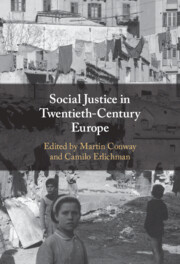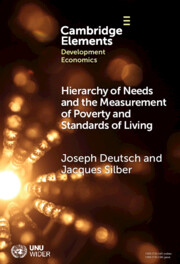374 results
The need for a broad perspective when assessing value-for-money for out-of-hours primary care
-
- Journal:
- Primary Health Care Research & Development / Volume 25 / 2024
- Published online by Cambridge University Press:
- 20 September 2024, e37
-
- Article
-
- You have access
- Open access
- HTML
- Export citation
The ‘Perfect Storm’: Food Banks and Food Insecurity During the Covid-19 Pandemic
-
- Journal:
- Social Policy and Society , First View
- Published online by Cambridge University Press:
- 18 September 2024, pp. 1-14
-
- Article
-
- You have access
- HTML
- Export citation
Efficiency vs. Welfare in Benefit–Cost Analysis: The Case of Government Funding
-
- Journal:
- Journal of Benefit-Cost Analysis , First View
- Published online by Cambridge University Press:
- 11 September 2024, pp. 1-28
-
- Article
-
- You have access
- HTML
- Export citation
4 - Black Markets, Green Expeditions
-
- Book:
- Streetscapes of War and Revolution
- Published online:
- 30 May 2024
- Print publication:
- 06 June 2024, pp 156-206
-
- Chapter
-
- You have access
- Open access
- HTML
- Export citation
3 - Shades of War
-
- Book:
- Streetscapes of War and Revolution
- Published online:
- 30 May 2024
- Print publication:
- 06 June 2024, pp 115-155
-
- Chapter
-
- You have access
- Open access
- HTML
- Export citation
Globalization, welfare, and inequality: Evidence from transoceanic market integration, 1815–1913
-
- Journal:
- Journal of Global History , First View
- Published online by Cambridge University Press:
- 29 April 2024, pp. 1-26
-
- Article
-
- You have access
- Open access
- HTML
- Export citation
1 - Social Justice
-
-
- Book:
- Social Justice in Twentieth-Century Europe
- Published online:
- 29 February 2024
- Print publication:
- 07 March 2024, pp 1-29
-
- Chapter
- Export citation
8 - Immigrants and Social Justice in Western Europe since the 1960s
-
-
- Book:
- Social Justice in Twentieth-Century Europe
- Published online:
- 29 February 2024
- Print publication:
- 07 March 2024, pp 163-184
-
- Chapter
- Export citation
5 - A Fascist Social Justice?
-
-
- Book:
- Social Justice in Twentieth-Century Europe
- Published online:
- 29 February 2024
- Print publication:
- 07 March 2024, pp 96-115
-
- Chapter
- Export citation

Social Justice in Twentieth-Century Europe
-
- Published online:
- 29 February 2024
- Print publication:
- 07 March 2024
38 - Judicial Decision-Making in Juvenile Dependency and Juvenile Justice Cases
- from Part V - Other Legal Decision-Making
-
-
- Book:
- The Cambridge Handbook of Psychology and Legal Decision-Making
- Published online:
- 22 February 2024
- Print publication:
- 29 February 2024, pp 582-598
-
- Chapter
- Export citation

Hierarchy of Needs and the Measurement of Poverty and Standards of Living
-
- Published online:
- 08 February 2024
- Print publication:
- 22 February 2024
-
- Element
-
- You have access
- Open access
- HTML
- Export citation
“I’m Not Worthless, I Do Help Society”: Exploring the Lived Experience of Community Placement in Activation Schemes
-
- Journal:
- Social Policy and Society , First View
- Published online by Cambridge University Press:
- 24 January 2024, pp. 1-15
-
- Article
-
- You have access
- Open access
- HTML
- Export citation
3 - Reconfiguring the Violence Against Women Act
-
- Book:
- Intersectional Advocacy
- Published online:
- 05 January 2024
- Print publication:
- 04 January 2024, pp 69-104
-
- Chapter
- Export citation
The view from Manywhere: normative economics with context-dependent preferences
-
- Journal:
- Economics & Philosophy / Volume 40 / Issue 2 / July 2024
- Published online by Cambridge University Press:
- 27 December 2023, pp. 374-396
-
- Article
-
- You have access
- HTML
- Export citation
11 - Inequality, Jobs, and Welfare
-
- Book:
- The Tortuous Path of South Korean Economic Development
- Published online:
- 07 December 2023
- Print publication:
- 21 December 2023, pp 357-399
-
- Chapter
- Export citation
23 - More on Economy and Culture in the Present Time
- from Part III - The Period after the 1970s
-
- Book:
- Monitoring the State or the Market
- Published online:
- 07 December 2023
- Print publication:
- 21 December 2023, pp 185-192
-
- Chapter
- Export citation
6 - Investing in Psychiatric Institutions and Expertise into the 1940s
- from Part III
-
- Book:
- Mandatory Madness
- Published online:
- 16 November 2023
- Print publication:
- 30 November 2023, pp 233-271
-
- Chapter
- Export citation
Evaluating the impact of sprinkler cycle and flow rate on dairy buffalo performance during heat stress
-
- Journal:
- Journal of Dairy Research / Volume 90 / Issue 4 / November 2023
- Published online by Cambridge University Press:
- 08 January 2024, pp. 357-362
- Print publication:
- November 2023
-
- Article
-
- You have access
- Open access
- HTML
- Export citation
Adaptive capacity and subsequent droughts: evidence from Ethiopia
-
- Journal:
- Environment and Development Economics / Volume 28 / Issue 6 / December 2023
- Published online by Cambridge University Press:
- 02 October 2023, pp. 511-537
-
- Article
-
- You have access
- Open access
- HTML
- Export citation

